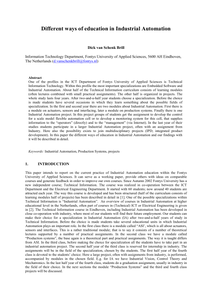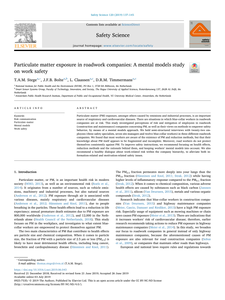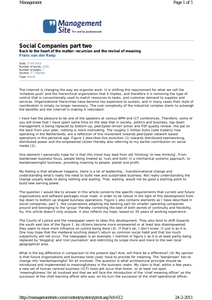The European Commission aims for a full circular economy (CE), an economy that aims to reuse all resources in 2050. CE is a promising way to increase welfare and wellbeing while decreasing environmental footprints. Industrial symbiosis, in which companies exchange residuals for resource efficiency, is essential to the circular transition. However, many companies are hesitant to implement business models for industrial symbiosis because of the various roles, stakes, opinions, and resulting uncertainties for business continuity.This dissertation supports researchers, professionals, and students in understanding and shaping circular business models for industrial symbiosis networks through collaborative modelling and simulation methods. Three theoretical perspectives, design science research, complex adaptive socio-technical systems, and circular business model innovation, shed light on designing business models for industrial symbiosis. A serious game and agent-based models were developed in multiple case studies with researchers, practitioners, and students. These were then used to design circular business models and explore their efficacy under uncertain conditions, such as various behavioural intentions of potential partners in diverse natural and societal contexts.This thesis advances business model design and experimentation by integrated simulation of social and technical aspects of industrial symbiosis. Furthermore, the research shows how simulations facilitate learning processes in designing circular business models. Ultimately, the thesis equips researchers, practitioners, and students with knowledge, tools, and methods to shape a circular economy.
DOCUMENT
The Internet is changing the way we organize work. It is shifting the requirement for what we call the ‘schedule push’ and the hierarchical organisation that it implies, and therefore it is removing the type of control that is conventionally used to match resources to tasks, and customer demand to supplies and services. Organisational hierarchies have become too expensive to sustain, and in many cases their style of coordination is simply no longer necessary. The cost complexity of the industrial complex starts to outweigh the benefits and the Internet is making it redundant.
MULTIFILE
Within the profile Technical Information Technology (ICT Department) the most important specializations are Embedded Software and Industrial Automation. About half of the Technical Information curriculum consists of learning modules, the other half is organized in projects. The whole study lasts four years. After two-and-a-half year students choose a specialization. Before the choice is made students have several occasions in which they learn something about the possible fields of specialization. In the first and second year there are two modules about Industrial Automation. First there is a module on actuators, sensors and interfacing, later a module on production systems. Finally there is an Industrial Automation project. In this project groups of students get the assignment to develop the control for a scale model flexible automation cell or to develop a monitoring system for this cell. In the last year of their studies students participate in a larger Industrial Automation project, often with an assignment from Industry. Here also the possibility exists to join multidisciplinary projects (IPD; integrated product development).
DOCUMENT

Particulate matter (PM) exposure, amongst others caused by emissions and industrial processes, is an important source of respiratory and cardiovascular diseases. There are situations in which blue-collar workers in roadwork companies are at risk. This study investigated perceptions of risk and mitigation of employees in roadwork (construction and maintenance) companies concerning PM, as well as their views on methods to empower safety behavior, by means of a mental models approach. We held semi-structured interviews with twenty-two employees (three safety specialists, seven site managers and twelve blue-collar workers) in three different roadwork companies. We found that most workers are aware of the existence of PM and reduction methods, but that their knowledge about PM itself appears to be fragmented and incomplete. Moreover, road workers do not protect themselves consistently against PM. To improve safety instructions, we recommend focusing on health effects, reduction methods and the rationale behind them, and keeping workers’ mental models into account. We also recommend a healthy dialogue about work-related risk within the company hierarchy, to alleviate both information-related and motivation-related safety issues. https://doi.org/10.1016/j.ssci.2019.06.043 LinkedIn: https://www.linkedin.com/in/john-bolte-0856134/
DOCUMENT

The Internet is changing the way we organize work. It is shifting the requirement for what we call the ‘schedule push’ and the hierarchical organization that it implies, and therefore it is removing the type of control that is conventionally used to match resources to tasks, and customer demand to supplies and services. Organizational hierarchies have become too expensive to sustain, and in many cases their style of coordination is simply no longer necessary. The cost complexity of the industrial complex starts to outweigh the benefits and the Internet is making it redundant.
MULTIFILE

A description of our experiences with a model for education in innovative, interdisciplinary and international engineering. (Students from different (technical) disciplines in Higher Education are placed in industry for a period of eighteen months after completing two-and-a-half year of theoretical studies). They work in multi-disciplinary projects on different themes, in order to grow to fully equal employees in industry. Besides students, teachers and company employees participate in the projects. The involvement of other level students, both from University and from Vocational Education, is recommended. The experiments in practice give confidence in the succesful implementation of this model.
DOCUMENT
The Internet is changing the way we organize work. It is shifting the requirements for what we call the “schedule push” and the hierarchical organization that it implies, and therefore it is removing the type of control that is conventionally used to match resources to tasks, and customer demand to supplies and services. Organizational hierarchies have become too expensive to sustain, and in many cases their style of coordination is simply no longer necessary. The cost complexity of the industrial complex starts to outweigh the benefits, and the Internet is making it redundant. The question I put forward in this Article, after a short description of how I envision “the change,” is what new requirements should be met by software in order to meet the requirements of the networked economy. Business will develop from Business-to-Consumer (B2C) to Consumer-to- Business (C2B) to People-to-People (P2P), customers more and more taking control over business activities, overhead being replaced by customer focus. This is also a new reality for the software world.
DOCUMENT

This is a repository containing an agent-based model (code, data, documents and results) of Industrial Symbiosis Network implementation. The repository is related to the publication:Lange, K.P., Korevaar, G., Nikolic, I., Herder, P.M., 2021. Actor Behaviour and Robustness of Industrial Symbiosis Networks: An Agent-Based Modelling Approach, 2020:64:4. JASSS. https://doi.org/10.18564/JASSS.4635The purpose of the model is to explore the influence of actor behaviour, combined with environment and business model design, on the survival rates of Industrial Symbiosis Networks (ISN), and the cash flows of the agents. We define an ISN to be robust, when it is able to run for 10 years, without falling apart due to leaving agents.The model simulates the implementation of local waste exchange collaborations for compost production, through the ISN implementation stages of awareness, planning, negotiation, implementation, and evaluation.One central firm plays the role of waste processor in a local composting initiative. This firm negotiates with other firms to become a supplier of their organic residual streams. The waste suppliers in the model can decide to join the initiative, or to have the waste brought to the external waste incinerator. The focal point of the model are the company-level interactions during the implementation or ending of synergies.The model consists of three types of actors, waste suppliers, processor, and incinerators. The modeled waste supplier and processor are part of the ISN. In the model these agent types negotiate and evaluate the outcomes by means of the Theory of Planned Behavior. The modeled incinerator is part of the external environment. This agent acts as the infinite sink of all waste flows, taking up op the waste that is not used in the local composting initiative.
DOCUMENT
Much research effort is invested in developing enzymatic treatments of textiles by focusing on the performance of enzymes at the laboratory scale. Despite all of this work, upgrading these developments from the laboratory scale to an industrial scale has not been very successful.Nowadays,companies are confronted with rapid developments of markets, logistics, and social and environmental responsibilities. Moreover, these organizations have to supply an ever-increasing amount of information to the authorities, shareholders, lobbyists, and pressure groups. Companies have tried to fulfill all of these demands, but this has often led to the loss of focus on new products and process development. However, both theory and practices of breakthrough innovations have shown that those rightfully proud of previous successes are usually not the ones that led the introduction of new technology, as shown and excellently documented by Christensen [1]. The textile industry is no exception to this observation.With the lack of management impetus for new product and process developments, companies began to reduce investments in these activities.However, this results in a reduction of the size of the company or even closure. Besides the hesitation from the top management of textile companies to focus on new developments,middle management level is also reluctant to evaluate and implement developments in new products and processes. One of the reasons for this reluctance is that many processes in the textile industry are notfully explored or known. From this lack of knowledge, it is easy to explain that there is hesitation for change, since not all consequences of a change in processing or production can be predicted. Often new developments cannot be fully tested and evaluated on the laboratory- or pilot-scale level.This is caused by the impossibility of mimicking industrial-scale production in a laboratory.Additionally, pilot-scale equipment is very expensive and for many companies it is not realistic to invest in this type of equipment. Fortunately an increasing number of textile companies have realized that they have to invest in new products and processes for their future survival and prosperity. New developments are decisive for future successes. If such companies decide to invest in new developments, it is clear that with the scarcity of capital for product and process developments, the chance of failure should be minimized. For successful process and product development, it is necessary to organize the development process with external partners because it is clear that it is almost impossible for individual textile companies to control the process from idea generation to academic research, implementation research, and development and industrial testing. These issues are especially characteristic for small- and medium-sized enterprises (SMEs). Herein, the collaboration has been organized on two research levels. The first research level is knowledge and know-how based. The universities and chemical suppliers worked closely together to investigate the new process.The aim was to explore the influence of process conditions and interactions of chemicals in sub-process steps as a result of the treatment.The second level is that of the industrial implementation of the new process. The universities and chemical suppliers worked closely together with different industries to implement the newly developed process. The focus in this part of the research was the interaction between the chemistry of the new process, equipment, and fabrics. A co-operation between the beneficiaries of the new process was established.The selection criterion for the co-peration was “who will earn something with the new process”. To answer this question, the value chain has been drawn as the simplified scheme shown in Fig. 1 [2].
MULTIFILE

This case study describes a special edition of the European Project Semester at the course Sustainable Packaging Design and Innovation at the Faculty of Industrial Design Engineering at The Hague University of Applied Sciences (Fall Semester 2017). In this special edition, unique cooperation took place between 12 parties. The parties were three research institutes, six universities, and three companies. Some parties have developed an educational module focused upon sustainable and circular packaging design, including the use of a dedicated tool for life cycle assessment. This module was embedded in the regular EPS. At The Hague University of Applied Sciences, an international class of 16 students worked in four teams on a real-life design assignment. They were offered a wide range of lectures, workshops, pitches, and presentations. The chapter concludes with a review of the followed processes and organizational, managerial, and practical concerns. Although run as a unique edition, all parties discuss to continue this cooperation.
DOCUMENT
